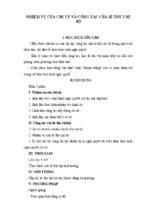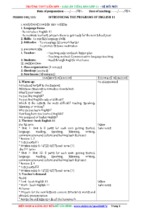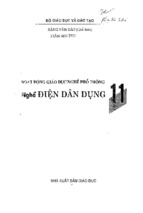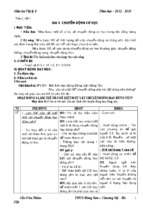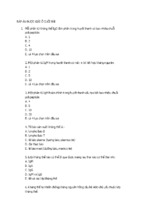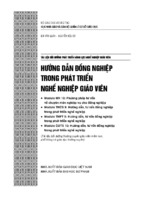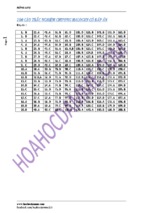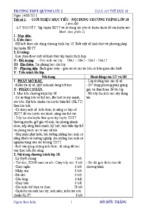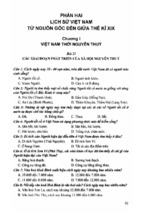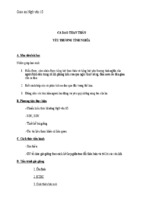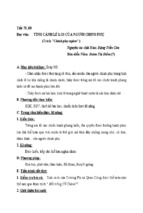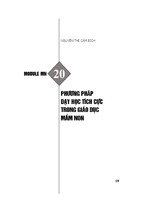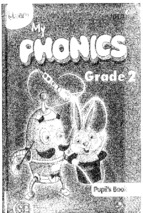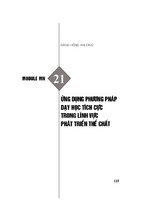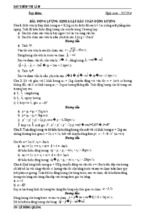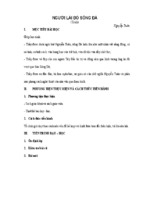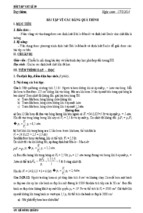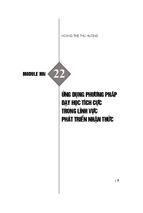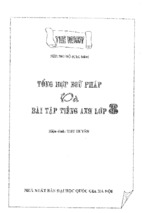English Lesson Plan - Grade 11
THE 2
ND
TERM
Date of preparing: 6/1/2017
Period: 56
UNIT 6: GLOBAL WARMING
LESSON 1: GETTING STARTED
OBJECTIVES OF THE UNIT:
- To use lexical items related to the global warming
- To identify and pronounce intonation in Yes-no questions and echo question.
- To use perfect gerunds and perfect participles
- To use must and have to to express obligation.
- To read for specific information in an article about global warming
- To express opinions, agreements, or disagreements about solutions to global warming
- To listen for specific information about the causes and effects of global warming
- To write an essay about the causes, effects and possible solutions to global warming.
- To understand the global warming problem and Young voices for the planet
I. Objectives of lesson 1
1. Educational aim
- To introduce the unit in general in order to
+ draw Ss’ attention to the topic “global warming” of the unit and its objectives
+ check Ss’ background knowledge of the global warming and their comprehension of the
language
- By the end of the lesson, Ss are able to
+ understand the content of the text correctly,
+ read the text fluently
+ do the activities well
2. Knowledge and skills:
* General language knowledge:
- Lexical items: chemical fertilizer, deforestation, ecological balance
- Grammatical structures/items: perfect gerunds and perfect participles
* Skills: - intonation in Yes-no questions and echo question
- Reading for specific information
II. Preparation:
- Teacher: lesson plan,
- Ss: reading and considering the tasks
III. Anticipated problems
Ss may ................................................................................................................ so T
should ..............................................................................................................
Teacher’s / Students’ activities
Content
I. WARM UP (5ms)
* Methods/techniques of teaching and learning: Introduction
-*T -T informs the class of the lesson
objectives: Introducing the topic, some
vocabulary related to global warming, the two
grammar points (perfect gerunds and perfect
participles), and intonation on yes-no questions
and echo questions.
II. NEW LESSON (37ms)
Task 1: Listen and read: (7ms)
* Methods/techniques of teaching and learning: communicative
-T asks Ss to look at the picture and tell them
English Lesson Plan - Grade 11
that the people are Mr Hoa and her students – - Answer T’s Qs
Mai, Minh and Lan. Mr Hoa is checking how
they are preparing for a team presentation on
global warming and is suggesting some ideas.
-T tells Ss that they are going to listen to the
conversation between Ms Hoa and her students.
-T plays the recording.
-T has Ss listen and read the conversation
silently.
-T tells Ss not to worry about the new
vocabulary as unfamiliar words will be dealt
with later in .
Play the recording. Have Ss listen and read at
the same time.
Task 2: Answer the questions (7ms)
* Methods/techniques of teaching and learning: Explaination
-This activity focuses on comprehension.
Expected answers:
-T tells Ss to read the questions carefully before Keys: 1. Global warming
they read the conversation the second time.
2. Three parts: the causes, the effects, the solutions
-T helps Ss with key words or phrases to make 3. Greenhouse gas emissions from factories and
sure that they understand all the questions.
vehicles; use of chemical fertilizers, and
-T lets Ss work in pairs to answer the questions. deforestation.
-T divides the class into three groups and has 3. Greenhouse gas emission, use of chemical
each group write their answers to separate fertilizers, deforestation
pieces of paper.
4. Climate changes, infectious and heat-related
-T divides the board into three sections.
diseases, impact on water supplies, threat to food
-T reads each question and has a S from each production and upset ecological balance
group stick their answer onto their section on 5. They should change their daily habits
the board.
6. Causes: burning of fossil fuels, using of non-T reads the three answers to each question and environment friendly products
has Ss decide on the correct or best one.
Effects: natural disasters such as floods, droughts,
- Checks and gives the correct answers:
tsunami, acid rain
Ss listen , do T‘s requests
Task 3: Complete the definitions: (7ms)
* Methods/techniques of teaching and learning: Instruction
T: -This activity focuses on the meaning of
some key words used in the conversation.
Keys: 1. C 2. G 3. D 4. B
5. A
-T encourages Ss to use the context and clues in H 8. F
the conversation.
-T asks Ss to read the conversation again and
find the phrases in the left-hand column and
underline them.
-T encourages Ss to guess the meanings of the
phrases and then match them with their
definitions in the right-hand column.
-T checks Ss’ answer as a class.
Task 4: Find all the phrases having + past participle with form. (5ms)
* Methods/techniques of teaching and learning: communication approach
T: This activity focuses on having + past
Do as appointed
participle of the verbs. Ask Ss to refer back to
the coversation and find all the phrases with the
– ing form. Have them compare theirs answers.
6. E
7.
English Lesson Plan - Grade 11
Check answers as a class
- Have Ss compare their answers in pairs/groups
- Check Ss’ answers.
III. WRAP UP (2ms)
* Methods/techniques of consolidation: . Individual work
- Ask Ss to consolidate the main contents.
- Ask Ss to tell class about conflicts between
different generation.
- Give feedback.
IV. HOMEASSIGNMENT (1ms)
- T asks Ss to learn by heart the words and
* Homework:
phrases related to globall warming
1. Learn by heart all of new words and give
- Prepare for the next lesson.
examples.
- Ss listen and take note
3. Prepare the next lesson carefully.unit 6 : lesson 2
(language)
Phu Ly………… ........, 2017
Group leader’s comments
Hoàng Thị Thanh Thủy
English Lesson Plan - Grade 11
Date of preparing: 10/1/2017
Period: 57
UNIT 6: GLOBAL WARMING
Lesson 2 : Language
I. Aims/Objectives
1. Educational aim: By the end of the lesson, Ss will be able to use lexical items related to global
warming.
2. Knowledge and skills:
* General language knowledge:
Words and phrases related to the topic
Understand and use “ having + past participle” of the verbs
* Skills: carrying out the exercises quickly and exactly
II. Preparation:
- Teacher: lesson plan, handouts,
- Ss: read the text in advance , look up new words and find some adjectives/nouns/verbs relating
to the topic
III. Anticipated problems
- Students may have difficulty recognizing the differences in pronunciation of the stressed words
with the mark ,so T should prepare those words and structures to help them.
IV. Procedure
Teacher’s / Students’ activities
Content
I. WARM UP (5ms)
* Methods/techniques of teaching and learning:
communication approach
- T asks Ss to make sentences using some words or phrases:
* Checking
- T corrects Ss’ answers and gives mark.
Ss give answers
II. NEW LESSON (37ms)
A. Vocabulary:(15ms)
* Methods/techniques of teaching and learning:
communicative
-This activity provides Ss with an opportunity to use the phrases
they learnt in Activity 3 in GETTING STARTED in the
sentences.
-T goes through the phrases and checks Ss’ understanding.
-T tells Ss to read each sentence carefully and use the contextual
clues to work which phrase best completes it.
-T asks Ss:
+What are the surrounding words?
+What do they mean?
-T lets Ss complete the sentences individually.
-T checks answers as a class.
Task 1: Matching
Keys: 1. carbon footprint
2. infectious diseases
3. emissions
4. ecological balance
5. heat-related illnesses
6. climate change
B. Pronunciation: (7ms)
* Methods/techniques of teaching and learning: Explanation
Intonation on yes-no questions and echo questions
Task 1: Listen and repeat:
1. Task 1
-This activity focuses on rising intonation on yes-no questions.
-T plays the recording and asks Ss to listen to the questions
English Lesson Plan - Grade 11
paying attention to the rising intonation at the end of each
question.
-T plays the recording again.
-T pauses after each question for Ss to repeat.
2. Task 2
-This activity focuses on rising intonation on echo questions.
-T asks Ss to read through the exchanges.
-T tells Ss that B’s responses are echo questions.
-T elicits from Ss what echo questions are and what intonation
pattern is usually used for them.
-T plays the recording for Ss to check the answers.
-T has Ss write an upward arrow after the echo questions.
-T lets Ss practise the exchanges in pairs.
1.
C. Grammar: (15ms)
* Methods/techniques of teaching and learning:
communication approach
Perfect participles in clauses of time and reason.
-T asks Ss to read the “Do you know…?” box and focus on the
form and use of perfect participles.
-T points out that perfect participles clauses can be rather formal
and are not often used in speech. However, these structures are
very useful in formal writing as they help combine information
into one sentence.
Task 1.
* Keys: 1. Having planned
After we have planned the content
…
2. Having treated
Because/Since humans have treated
the ….
1. Task 1
-The aim of this activity is to help Ss to understand the meaning
of perfect participles in sentences and how to use them in clauses
of time and reason.
-T asks Ss to read the sentences with perfect participles they have
written down in 4 in GETTING STARTED and discuss with a
partner how the perfect participle is used in each sentence.
-T tells Ss to rewrite the sentences individually.
-T checks as a class.
2.Task 2
Perfect gerunds
-The aim of this activity is to show Ss how the perfect gerund can
be used to emphasize that an action had happened in the past,
before the past action denoted by the main verb of the sentence.
-T points out the two structures:
+Verb + O + Preposition + perfect gerund verb +
Perfect gerund.
-T tells Ss that in many cases the perfect gerund is optional since
it is often obvious from the context which action takes place first
so the simple gerund can be used as well.
E.g.
She denied breaking the flower vase
-T asks Ss to underline the verbs in the second sentences that will
be used as the main verbs or verb phrases in the combined
sentences.
-T elicits from Ss each verb or verb phrase.
-T has Ss pay attention to any prepositions that need to be added.
E.g. Suspect (suspect somebody of doing / having done
Task 2. Matching and combine the
sentences
* Keys: 1. e
2. c
something).
-T has Ss do the activity individually first, then compare their
answers with a partner.
-After that, T checks as a class.
-T tells Ss to read the “Do you know….”box.
-For weaker Ss, T provides more examples with the verbs
followed by a gerund (simple or perfect one).
-For stronger Ss, T has them work in pairs and make as many
sentences as they can.
- T asks Ss to exchange the answers with their partner.
- T gives feedback.
+Ss work individually to do the task, then discuss their answer
with their peers
+ write their answers on the board
English Lesson Plan - Grade 11
3. a
4. b
5. g
6. h
7. f
8. d
Keys:
1.The students in group 11G were
praised for having planted the most
trees in the schoolyard in the Tree
Planting Competition
2. The police suspected Mike of
having cut down the oldest tree in
the park
3. He denied having dumped lots of
rubbish onto the beach
4. Thank you for having saved the
lives of hundreds of wild animals
5. They regretted having hunted
and killed many wild animals
6. The factory was heavily fined for
having dumped tons of toxic waste
into the river
7. Denis was rewarded for having
taken an active part in the Green
Summer activities
III. WRAP UP (2ms)
* Methods/techniques of consolidation: . communication
approach
- Ask Ss to consolidate the main contents.
- Give feedback.
IV. HOMEASSIGNMENT (1ms)
- T asks Ss to do exercise at home.
- Prepare for the next lesson.
- Ss listen and take note
* Homework:
1. Exercises in workbook: A,B
2.. Prepare the next lesson
carefully.unit 6 : lesson 3 Reading
Phu Ly………… ........, 2017
Group leader’s comments
Hoàng Thị Thanh Thủy
English Lesson Plan - Grade 11
Date of preparing: 10/1/2017
Period: 58
UNIT 6: GLOBAL WARMING
Lesson 3 : Reading
I. Aims/Objectives
1. Educational aim: By the end of the lesson, Ss will be able to read for read for general ideas
and specific information about “GLOBAL WARMING”.
- read for specific in an article about“GLOBAL WARMING”., understand word meaning in
context and understand references.
2. Knowledge and skills:
* General language knowledge:
Words and phrases related to the topic “GLOBAL WARMING”.
* Skills: - guessing meaning of words/phrases in a text
- answer questions in a text
II. Preparation:
- Teacher: lesson plan, handouts,
- Ss: read the text in advance , look up new words
III. Anticipated problems
- T may not have enough time to do all the tasks , so T can ask Ss to do the left at home
IV. Procedure
Teacher’s / Students’ activities
Content
I. WARM UP (5ms)
* Methods/techniques of teaching and learning: communication approach
-T -T informs the class of the lesson objectives: Skimming and
scanning a text for general ideas and specific information.
- Ss give answers
II. NEW LESSON (37ms)
Task 1: Discuss (7ms)
* Methods/techniques of teaching and learning: communicative
1. -This activity is a pre-reading activity which aims to get Ss Task 1: Discuss the problems
involved in the lesson and help them to activate their prior depicted in the pictures
knowledge about the topic.
-T has Ss work in pairs, discuss the problems depicted in the
pictures (greenhouse gas emissions from factories and cars,
deforestation, etc.) and answer the question.
-T invites some pairs to present their answers to the class.
-T don’t correct Ss’ mistakes at this stage of the lesson.
-T just praises them for expressing their opinions and tell them
to compare their ideas with those in the text after they have read
it.
- Ask some Ss to share their opinions with the whole class.
- T- Check their answers
Task 2. Read the text and choose the best answer(3ms)
* Methods/techniques of teaching and learning: Explaination
English Lesson Plan - Grade 11
2. T: -This activity provides Ss with an opportunity to practise Task 2:
reading for gist and summarizing key ideas into a statement.
* Keys: The best title of the text is
-T asks Ss to read the text quickly and choose the statement that "Global warming is mainly caused
best expresses the main idea.
by humans and has negative
-T helps Ss to eliminate the wrong options by analyzing them:
impacts on people’s lives"
+Option a is a definition of global warming.
+b mentions only about one of the effects of global warming
explained in the text.
+c is the most comprehensive one since it mentions both causes
and effects.
+d mentions only one solution.
+c is the best answer as it covers all points mentioned in the text.
Ask Ss to skim the text
Ss: Work individually first, then compare their answers in pairs .
T- Check their answers
Task 3: Matching words with the definitions (4ms)
* Methods/techniques of teaching and learning: communication approach
- 3. T: Ask Ss to find the words in the text with the definitions
given.
Task 3:Matching
- Have Ss work individually, then check their answers in groups. Keys: 1. G 2. F 3. D 4. E 5.
Ss: Skim the text and compare the answers.
B 6. A 7. C
Work individually, then compare the answers in groups
T - Check the answers again as in class
Task 4. Answer the questions(7ms)
Methods/techniques of teaching and learning: communication approach
- T asks sts to read all the questions, check if they understand all
the question and underline key words of each question before
* Keys: 1.We are responsible
finding the answer.
2. It releases a large amount of
- Sts work in pairs to underline the answers in the text. Finally, 6 carbon dioxide into the atmosphere
sts say the answers, if an answer is incorrect, T tries to elicit it
3. Deforestation disrupts the process
from other sts.
of absorbing and capturing C02
T- Check their answers
from the atmosphere
4. They could lose their home
5. They can reduce crop harvest
globally
6. Because human beings cannot
exist without species diversity on
earth
Task 5. - Discussion (7ms)
Methods/techniques of teaching and learning: communication approach
- T - Arrange Ss into groups and set a time limit. T walks round
to monitor the class and offer s help if necessary.
- Have Ss work in groups and take turns to share their problems
- ask some pairs to report the results of their discussion
III. WRAP UP (2ms)
* Methods/techniques of consolidation: . communication approach
-tell Ss what they have learnt
- Asks Ss: What have you learnt today
- Calls on some Ss to report their ideas to the class
.
IV. HOMEASSIGNMENT (1ms)
- T asks Ss to do exercise at home.
- Prepare for the next lesson.
- Ss listen and take note
English Lesson Plan - Grade 11
* Homework:
1. Learn by heart new words
2.. Prepare the next lesson
carefully.unit 6 : lesson 4: Speaking
Phu Ly………… ........, 2017
Group leader’s comments
Hoàng Thị Thanh Thủy
English Lesson Plan - Grade 11
Date of preparing: 10/1/2017
Period: 59
UNIT 6: GLOBAL WARMING
Lesson 4 : Speaking
I. Aims/Objectives
1. Educational aim: - By the end of the lesson Ss will be able to talk about “GLOBAL
WARMING”..
1. Language focus - To provide learners some vocabulary related to the topic of “GLOBAL
WARMING”.
- To provide learners different expressions of uses and benefits
2. Skills - To promote Ss to develop their speaking skills
- To help Ss develop the skill of working in pairs and groups
3. Attitudes - To encourage Ss to work harder
- To provide Ss some motivation
II. Preparation:
- Teacher: lesson plan, chalks , textbook
- Ss: prepare the lesson
III. Anticipated problems
- Ss may be afraid of speaking in public , so T should encourage Ss to participate in the lesson
IV. Procedure
Teacher’s / Students’ activities
Content
I. WARM UP (5ms)
* Methods/techniques of teaching and learning: communication approach
T: Inform the class of the lesson objects :
Introduce the topics by asking Qs
II. NEW LESSON (37ms)
Task 1: Discuss which of the activities in the table can help reduce global warming.(12ms)
* Methods/techniques of teaching and learning: communicative
-This activity is the first step in preparing Ss for Task 1: *Key: 1, 2, 4, 5, 6
achieving the final objective of the Speaking lesson –
expressing ideas/ agreements/ disagreements about
solutions to global warming.
-T has Ss read the activities carefully.
-T explains any new words/ phrases, if necessary.
-T asks Ss to work in pairs and discuss which of the
activities in the table can help reduce global
warming.
-T checks answers as a class.
-T might also be necessary to explain the following
points:
+”Travelling by air around the world to study global
warming” may contribute to the increase of global
warming instead of reducing it as air travel and other
forms of transport such as motor vehicles, rail and
sea transport are main sources of CO2 emissions.
-Just “Living in forest surrounded by a diverse
population of species” cannot stop deforestation or
protect species from extinction.
English Lesson Plan - Grade 11
Task 2. Matching (10ms)
* Methods/techniques of teaching and learning: Explaination
-Ask Ss to look at the task 2.
-This activity helps Ss link the activities
in 1 to the specific reasons why they can
help to reduce global warming.
Task 2:
-T has Ss read the reasons carefully.
KEY: 1e , 2b , 4c , 5a, 6d
-T explains any words or phrases if
necessary.
-T demonstrate to Ss how they can use the
clues or key words in the reasons to
determine the activities they relate to.
-For example, in reason a, the clue are
“petrol” and “vehicle” as these words are
related to “transport” and “bicycle”.
-T has Ss work in pairs to match the
reasons with the activities.
-T checks as a class.
Task 3.Complete the conversation (10ms)
* Methods/techniques of teaching and learning: Explaination
-This activity provides Ss with a model Task 3:
conversation expressing ideas, agreement Keys:
and disagreement.
1. energy use
-T asks Ss to read the conversation and 2. electronic devices
use the words in the box to fill in the 3. planting trees
blanks individually.
4. carbon dioxide
-T has Ss work in groups to role-play the 5. reusing and recycling
conversation.
Task 3: Make the similar conversation (10ms)
* Methods/techniques of teaching and learning: communication approach
-This activity is free practice: Ss use the Task 3: Make the similar conversation
activities and reasons they learnt in 1 and
2 and the model conversation in 3 to
express their own ideas.
-T puts Ss into groups of three.
-T asks Ss to exchange their ideas and
express agreement or disagreement about
solutions to global warming.
-While Ss are doing the activity, T walks
around the class to offer support if
necessary.
-T invites one or two groups to role-play
their discussions in front of the class.
-T provides comments and corrects any
frequently occurring mistakes.
.Ask Ss to work in groups
- Encourage Ss to use the structures listed
in.
- Walk around and help Ss if neccesary.
Ss -Present orally in pairs.
English Lesson Plan - Grade 11
3.
Task 4: Make the similar conversation
Ask Ss to work in pairs
- Encourage Ss to use the structures listed
in.
- Walk around and help Ss if neccesary.
- Ask some pairs to role-play their
conversation, and give feedback on their
performance
Ss -Present orally in pairs.
III. WRAP UP (2ms)
* Methods/techniques of consolidation: . communication approach
- Ask Ss to consolidate the main contents.
- Give feedback.
IV. HOMEASSIGNMENT (1ms)
- T asks Ss to do exercise at home.
* Homework:
- Prepare for the next lesson.
1. write the dialogue in the notebook
- Ss listen and take note
2.. Prepare the next lesson carefully.unit 6 : lesson 5
Listening
Phu Ly………… ........, 2017
Group leader’s comments
Hoàng Thị Thanh Thủy
English Lesson Plan - Grade 11
Date of preparing: 15/1/2017
Period: 60
UNIT 6: GLOBAL WARMING
Lesson 5 : Listening
I. Aims/Objectives
1. Educational aim:
By the end of the lesson Ss will be able to listen for gist and specific information in a sports
instructor’s talk about the global warming..
+ Develop the listening skills for details and for specific details.
+ talk about the global warming
2. Knowledge and skills:
* General language knowledge:
- Words and phrases related to the topic about the global warming
* Skills:
+ Listen to a sports instructor’s talk and do the true or false exercise and complete the table.
II. Preparation:
- Teacher: lesson plan, chalks , textbook, pieces of papers and cassette
- Ss: prepare the lesson
III. Anticipated problems
- Students may have difficulty understanding some words and structures, so T should
prepare those words and structures to help sts
IV. Procedure
Teacher’s / Students’ activities
Content
I. WARM UP (3ms)
* Methods/techniques of teaching and learning: communication approach
-T informs the class of the lesson objectives: Listening
to a talk by a professor for specific information about
the causes and effects of global warming.
II. NEW LESSON (37ms)
Task 1:. Matching (8ms)
* Methods/techniques of teaching and learning: communicative
-This activity is a pre-listening activity with aims to
introduce the topic of the listening text and get Ss to
brainstorm ideas related to the topic.
Suggested questions:
A.-T asks Ss to match the words with the pictures.
1c, 2d, 3a,4e,5b
-T has Ss read aloud the words in pairs to make sure
that they can pronounce them.
B.-T asks Ss to discuss the question in pairs.
-T encourages Ss to write down their answers so that
they can compare them later,
- Have Ss compare their answers. Check their answers.
- Teacher may explain some new words if necessary.
Task 2. Choose the best answers(6ms)
* Methods/techniques of teaching and learning: Explanation
2.T-This activity focuses on the skill of listening for Answers:
specific information.
. KEY: 1.d 2.b 3.b 4.c 5.a
-T tells Ss to read through the questions and the answer
options so that they have some idea about what they
have to listen for.
-T helps Ss to identify the key words in each question.
-T plays the recording without pausing.
English Lesson Plan - Grade 11
-T has Ss answer the questions individually.
-T lets Ss compare their answers with a partner.
-T checks as a class. If there are many wrong answers,
play the recording again, pausing where Ss may have
difficulty understanding the listening text or where Ss
can get the answer to a specific question
Task 3: Listen and answer the questions (8ms)
* Methods/techniques of teaching and learning: communication approach
-This activity provides further comprehension practice Task 3: Listen and answer the questions
on the listening text by open-ended questions.
Keys:
-T has Ss read the questions and asks them to pay 1. Carbon dioxide, carbon monoxide
attention to the key word(s) in each of them.
2. The thick layer of the greenhouse gases traps
-T plays the recording again.
more heat from the sun leading to the increase
-T asks Ss to take notes while listening and then use of the temperature on the earth
the notes to answer the questions.
3. Heat waves, floods, droughts and storm
-For a weaker class, T pauses after the information for surges.
each question.
4. Famine, water shortages, extreme weather
-T lets Ss compare their answers in pairs.
conditions and a 20-30% loss of animal and
-T checks as a class.
plant species.
5. When you have a lot of information about the
topic, you’ll be more willing to change your
lifestyle and you’ll be able to inform others and
inspire change.
Task 4: Discuss the changes in weather patterns in Viet Nam over the last ten years.(8ms)
* Methods/techniques of teaching and learning: communication approach
-This activity is a post-listening one, which provides Ss Task 4:
with an opportunity to relate the content of the
listening text to their own situation.
-T puts Ss into groups to discuss the changes in
weather patterns in Viet Nam over the last ten years.
-For a weaker class, T gives Ss some hints such as
longer summer, heat waves, floods, drought, storms,
etc.
-T invites Ss from one or two groups to report the
results of their discussion.
-T gives encouraging feedback and correct only
frequently occurring mistakes.
III. WRAP UP (2ms)
* Methods/techniques of consolidation: . communication approach
- Ask Ss to consolidate the main contents.
.
- Give feedback.
IV. HOMEASSIGNMENT (1ms)
- T asks Ss to do exercise at home.
* Homework:
- Prepare for the next lesson.
1. Learn new words by heart :
- Ss listen and take note
2.. Prepare the next lesson carefully in unit 6 :
lesson 6 Writing
Phu Ly………… ........, 2017
Group leader’s comments
Hoàng Thị Thanh Thủy
English Lesson Plan - Grade 11
Date of preparing: 15/1/2017
Period: 61
UNIT 6: GLOBAL WARMING
Lesson 6 : Writing
I. Aims/Objectives
1. Educational aim:
- By the end of the lesson, Ss will be able to Write a short brochure introducing an global warming
+ Develop the writing skills in general. Build up vocabulary supported for writing.
2. Knowledge and skills:
* General language knowledge: some words and structures related to global warming
* Skills
- read the lists , fill a chart
II. Preparation:
- Teacher: lesson plan, chalks , textbook, pieces of papers
- Ss: prepare the lesson
III. Anticipated problems
Students may have difficulty using some words and structures to express their ideas ,so T should
prepare those words and structures to help sts
IV. Procedure
Teacher’s / Students’ activities
Content
I. WARM UP (5ms)
* Methods/techniques of teaching and learning: communication approach
* -T informs the class of the lesson
objectives: by the end of the lesson, Ss
should be able to write an essay about the
causes and effects of global warming and
possible solution to it.
II. NEW LESSON (37ms)
Task 1: Fill in the gaps (8ms)
* Methods/techniques of teaching and learning: communicative
. 1. -The aim of this activity is to provide
some ideas and prepare Ss for the lesson’s
final writing task.
Suggested answers:
-T draws the diagram on the board and Causes: 2, 4, 7
explains to Ss its different parts: there are Effects: 1, 3
6, 8
several causes leading to global warming,
5
9
which has a number of effects on human
life and nature; then some of these effects
can cause further impact on humans and
nature.
-T puts Ss into pairs.
-T asks Ss to read the phrases carefully
and decide which of them are causes and
English Lesson Plan - Grade 11
which are effects.
-T reminds Ss that they have already
learnt about these causes and effects in
the reading and listening lessons.
-T asks a pair of Ss to come to the board
and complete the diagram.
-T checks answers as a class.
Task 2. Discuss complete the outline (12ms)
* Methods/techniques of teaching and learning: Explanation
-The aim of this activity is to help Ss to Answers:
develop an outline before they start 1. Introduction (introduce topic and the main contents)
writing their essays.
- one of the biggest issues facing humans nowadays
-T reminds Ss that all the ideas necessary - caused mainly by humans
for the outline have been provided for - most catastrophic effects on humans
them in the previous parts of the unit.
- humans have to take actions to reduce the risks
-T tells Ss that they can complete the - the essay will discuss the causes and effects, and possible
outline with just phrases, not complete solutions
sentences.
2. What global warming is and its cause
-T writes the outline on the board and - the rise in the average temperature of the earth due to the
asks some Ss to complete the part of the increase of greenhouse gases in the atmosphere
outline about the causes and effects while - causes
others complete the outline in their Carbon dioxide emission
notebooks.
Deforestation for farming land
-T checks as a class.
Increasing use of chemical fertilizers on cropland
-T has Ss work in pairs to think about the 3. Effects of global warming
possible solutions to reducing global - heat related diseases and death, and spread of infectious
warming.
diseases
-T reminds Ss of the solutions they have - melting of polar ice caps and rising of sea levels
discussed in the speaking lesson.
- extreme weather patterns such as severe storm, heat
waves, floods and droughts
- widespread extinction of species
4. Some possible solutions
- reduce energy use
- planting trees or plants
- Using green methods of transportations
Task 4: Write the text for the brochure (17ms)
* Methods/techniques of teaching and learning: communication approach
T- -The product of this activity should be
Ss’ completed essays.
Answers:
-T asks Ss to write their essays
individually using the helpful expressions
in the box and the outline they have Students’ answers
completed.
To begin with:
-T lets Ss work in pairs swapping their
The deforestation for farmland, wood and paper
essays for their partners to read and give contributes to higher temperatures which lead to the
comments.
melting of polar ice caps and rising of sea levels
-If time is limited, this activity can be
assigned as homework.
Alternatively. Ss can write the text for the
brochure at home. They can also add
some photos to inlustrate each paragraph
and make their brochures look attractive.
T collects Ss’ brochures the next class.
English Lesson Plan - Grade 11
Give feedback and comments or invite Ss
to show the best brochures and present
the information in class.
-After Ss finished the writing, T gives
some general comments and writes the
good ideas in one column and errors in
another.
-T asks the class to comment on the ideas
and correct the errors.
III. WRAP UP (2ms)
* Methods/techniques of consolidation: . communication approach
- Ask Ss to consolidate the main contents.
- Give feedback.
IV. HOMEASSIGNMENT (1ms)
- T asks Ss to do exercise at home.
* Homework:
- Prepare for the next lesson.
1. Rewrite
- Ss listen and take note
2.. Prepare the next lesson carefully.unit 6 : lesson 7
Communication and Culture
Phu Ly………… ........, 2017
Group leader’s comments
Hoàng Thị Thanh Thủy
English Lesson Plan - Grade 11
Date of preparing: 15/1/2017
Period: 62
UNIT 6: GLOBAL WARMING
Lesson 7 : Communication and culture
I. Aims/Objectives
By the end of the lesson, Ss will be able to further skill development
1. Language focus - Communication samples and cultural items
2. Skills
- To promote Ss to develop their communication skills and cultural understanding
- To help Ss develop the skill of working in pairs and groups
3. Attitudes - To encourage Ss to work harder
- To provide Ss some motivation
II. PREPARATION
1. Teacher - Teaching aids: textbook, lesson plan
- Teaching method: Communicative language teaching
2. Students - Read through English Unit 6 - Communication and Culture at home
III. Anticipated problems
Students may have difficulty using some words and structures to express their ideas ,so T should
prepare those words and structures to help sts
IV. Procedure
Teacher’s / Students’ activities
Content
I. WARM UP (5ms)
* Methods/techniques of teaching and learning: communication approach
-Ask ss to answer his/he qs by looking at
the pictures.
-Answer the qs
II. NEW LESSON (37ms)
Task 1: Communication (8ms)
* Methods/techniques of teaching and learning: communicative
A. Communication.
1. -This activity aims at developing Ss’
presentation skills on the topic of global Key :
warming.
KEY: 1.c 2.e 3.b 4f .5.d
-T tells Ss that they have to present a talk
to an environmental club about one of the
causes of global warming and its effects.
In the talk, they will also have to suggest
some solutions related to the problems.
-T asks Ss to read the causes in the
Writing section and choose the one they
think is the most important and want to
talk about.
-T has Ss study the outline in groups or
pairs before they start preparing for their
6.a
English Lesson Plan - Grade 11
talk.
-T encourages Ss to practise their talks
with their partners.
-T invites one or two Ss to present their
talk to the class.
-T gives comments focusing on the
structure of the talk and Ss’ presentation
skills.
-T encourages other Ss to give comments,
too.
Task 2. Culture. (12ms)
* Methods/techniques of teaching and learning: Explaination
B. Culture.
-The aims of this section is to provide Ss
with information about how young people
can help to reduce global warming.
-As a warm up activity, T asks if Ss know
anything about Young Voices for the
Planet or what the name tell them.
-T has Ss brainstorm ideas, but do not
correct them at this stage of the lesson.
-T tells Ss that they will find out more
after they read the text.
-Some of the words/phrases in the text
may be difficult or unfamiliar. T has Ss
guess their meaning or, to save time.
-T provides the equivalent words or
explanation in Vietnamese.
1. Task 1
-T asks Ss to read the text carefully and
answer the questions 1-4.
-T checks as a class.
-To make the activity more interesting
and to save time, T use the “jigsaw
reading” strategy, T puts Ss into groups of
four.
-Each S in the group has to read one
paragraph and then answer the question(s)
related to the content of that paragraph.
2.Task 2
-The aim of this activity is to encourage
Ss to relate the text content to the
situation in Vietnam.
-T puts Ss into groups to discuss the
questions.
-T invites one or two groups to present
their answers to the class.
Vocabulary:
+awareness
+be proud
+clean-up
+lawmaker
Suggested answers:
1. It is a series of short films that tell real stories about the
different ways young people have contributed to reducing
the carbon footprint of their homes, schools, communities
and countries.
2. Because he has learned about how trees can help to
reduce the amount of carbon dioxide in the atmosphere
3. To raise money for the clean-up of the BP oil spill in the
Gulf of Mexico in 2010.
4. One student stood covered in plastic bags in front of city
lawmakers and asked them to ban plastic bags
III. WRAP UP (2ms)
* Methods/techniques of consolidation: . communication approach
- Ask Ss to consolidate the main contents.
- Give feedback.
IV. HOMEASSIGNMENT (1ms)
- T asks Ss to do exercise at home.
* Homework:
- Prepare for the next lesson.
1- learn the structures and vocabularies.
- Ss listen and take note
English Lesson Plan - Grade 11
2- Prepare for the next lesson. Lesson 8:looking back and
project
- Xem thêm -

